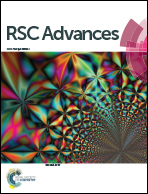One-pot synthesis of heterostructured Bi2S3/BiOBr microspheres with highly efficient visible light photocatalytic performance†
Abstract
To overcome the drawback of low photocatalytic efficiency brought by fast electron–hole recombination and narrow photoresponse range, the heterostructured Bi2S3/BiOBr microspheres were designed and synthesized via a facile one-pot solvothermal method. The as-prepared heterostructured Bi2S3/BiOBr photocatalyst exhibits significantly enhanced photoelectrochemical performance and photocatalytic activity for decomposing rhodamine B (RhB) and Brilliant ponceau 5R (BP) compared with pure BiOBr under visible light irradiation, which could be mainly attributed to the formation of a heterojunction in the Bi2S3/BiOBr interface, which can efficiently facilitate the separation of photogenerated electron–hole pairs. Furthermore, a terephthalic acid photoluminescence (TA-PL) probing test and radical trapping experiments demonstrate that the h+ and ·O2− radicals are the dominant reactive species while ·OH radicals could be neglected. In addition, the possible enhanced photocatalytic mechanism is proposed on the basis of the calculated energy band positions and radical trapping experiments.


 Please wait while we load your content...
Please wait while we load your content...